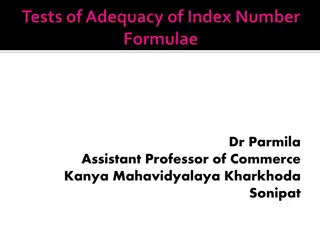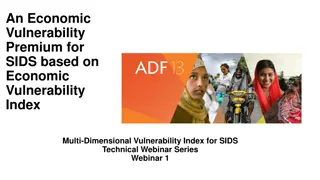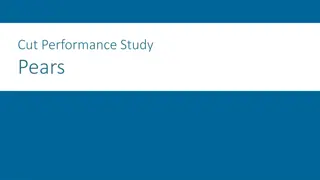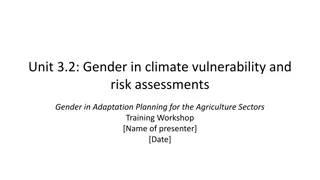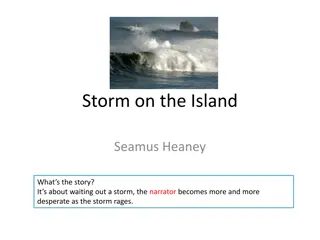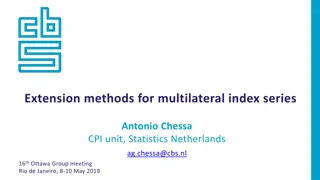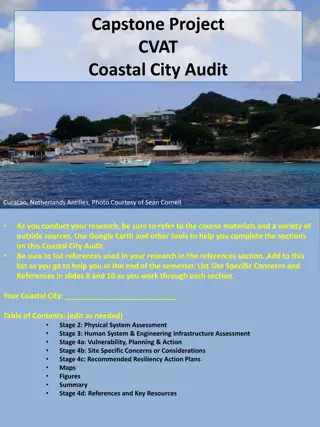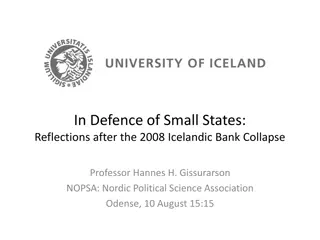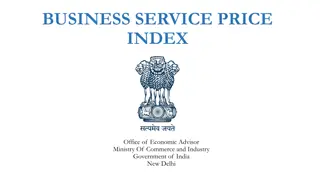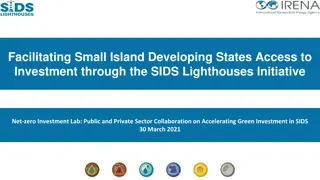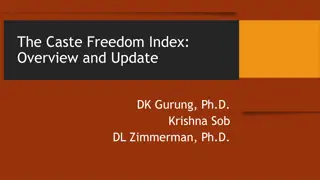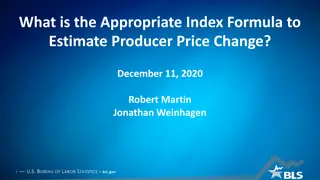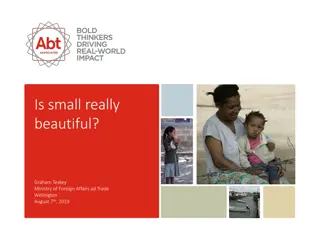Understanding the Vulnerability Index for Small Island Developing States
This article discusses the concept of vulnerability in the context of countries, focusing on Small Island Developing States (SIDS). It explores the differences between vulnerability and poverty, the history of vulnerability index development from SIDS to Least Developed Countries (LDCs), and critiques the existing vulnerability indices. The importance of governance and policy interventions in addressing economic vulnerability is also highlighted.
Download Presentation

Please find below an Image/Link to download the presentation.
The content on the website is provided AS IS for your information and personal use only. It may not be sold, licensed, or shared on other websites without obtaining consent from the author. Download presentation by click this link. If you encounter any issues during the download, it is possible that the publisher has removed the file from their server.
E N D
Presentation Transcript
THE VULNERABILITY INDEX WITH A FOCUS ON SMALL ISLAND DEVELOPING STATES Lino Briguglio University of Malta Prepared for an UNDESA Technical Webinar on A Multi-Dimensional Vulnerability Index for SIDS Date: 9th April 2021
Contents 1. The vulnerability Index: Background 2. Computing the vulnerability index 3. Multidimensional vulnerability Index 4. Pitfalls to be avoided 5. Economic resilience 6. The vulnerability and resilience framework 7. Concluding comments
The meaning of the term What is meant by the term vulnerability in the context of a country. I this context I always defined it as exposure of a country to adverse external shocks not of the country s own making or something similar. It is well known that small island developing states (SIDS) tend to be highly exposed to external economic shocks because of their inherent characteristics, mostly associated with a high degree of trade-openness. It should be emphasised also that vulnerability is not the same thing as poverty. A country with a high degree of vulnerability may experience stability and succeed economically if policies are put in place to enable it to withstand exposure to external shocks. Conversely a country with a low degree of exposure to external shocks, but is weakly governed, may experience economic instability and poverty.
Reference to the vulnerability index in the BPoA Paragraphs 113 and 114 of the BPoA In these paragraphs, the 1994 Barbados Programme of Action, the outcome document of the 1994 SIDS Conference, called for the development of a vulnerability index. This Programme was endorsed by the General Assembly in its resolution 49/122 of 19 December 1994. Follow up on the BPoA As a follow-up, in 1997, the Department of Economic and Social Affairs engaged two consultants, one of which was myself, to develop an economic and an ecological vulnerability index. The Department convened an ad hoc expert group to review our technical work and to make appropriate recommendations.
From SIDS vulnerability to LDC vulnerability From SIDS to LDC vulnerability Subsequently, a Working Group of the UN Committee for Development Planning reviewed our work, and agreed about the usefulness of the vulnerability index as a criterion for the designation of the least developed countries (LDC). This led to the UN Committee for Development Policy (CDP) to adopt an alternative vulnerability index in connection with the designation of countries as LDC. The CDP vulnerability Index I had occasion to criticise the CDP vulnerability index, in the context of SIDS, mostly because, amongst other things, it contains sub-indices relating to instability, which is an outcome not a cause of economic vulnerability and, in addition, could also be an outcome of weak domestic governance. I will discuss this matter further later on.
Objective of this presentation A recent request made to the UN Secretary-General by the UN General Assembly (Para 8(a) of Resolution A/RES/75/215), related to the issue of an Multidimensional Vulnerability Index for SIDS, which remains an unresolved matter. In this presentation, based on past efforts and experience, I will discuss what, in my opinion are the key elements that the UN system need to take into consideration to ensure a satisfactory outcome of this process, that is an outcome that could garner general support from UN members, both developed and developing and the donor community, including the World Bank and other Multilateral Development Banks.
Components of the economic vulnerability index Various vulnerability indices were developed since 1995, but I wish to discuss the one that I developed as an academic at the University of Malta, which was possibly the earliest one. It consisted of four components namely: Trade-openness (dependence on exports and imports) which render an economy highly exposed to shocks. Export concentration (dependence on a few categories of exports) which exacerbates exposure to shocks. Dependence on strategic imports including food and fuel, which are highly price and income inelastic also exacerbate exposure to shocks. Proneness to disasters, lead to economic shocks and exacerbate the effects of external shocks. These features, that render a country exposed to external shocks, are permanent of quasi permanent, and therefore not self-inflicted. The index showed that the vulnerability scores for SIDS tended to be very high, when compared to other countries.
The components of the vulnerability index trade- openness Export concent- ration Economic Vulnerability Proneness disasters Dependence on strategic Imports
SIDS are highly vulnerable 1.0 The diagram on the left shows the Economic Vulnerability Index, re-scaled from 0 to 1 (as calculated by the present author) relating to country size, measured in terms of population size. Vulnerability Index 0.8 0.6 0.4 Vulnerability indices of the type constructed by the present author generally conclude that small states, especially island ones, tend to be more economically vulnerable than other groups of countries, as indicated by the backward sloping trend line. 0.2 0.0 1 3 5 7 Log of Population Size Source: Briguglio, L. (2016). Exposure to external shocks and economic resilience of countries: evidence from global indicators, Journal of Economic Studies, Vol. 43(6):1057-1078.
Inherent features vs self-inflicted harm I often expressed the view that if the Vulnerability Index is to be operationally useful for SIDS, in order for them to make a case for support from the international community, it must not include variables that relate to self-inflicted harm, but to inherent features that are permanent or quasi-permanent features which render countries exposed to external shocks. A point that I wish to refer trade-openness , which I will discuss further below. I consider trade-openness as inherent because as country-size gets smaller, the need for a country to look beyond its small domestic market becomes a necessity for survival. Trade-openness may be interpreted as a choice for a country, but in reality small states have no alternative but to seek external markets.
Studies on a multidimensional vulnerability index Recently there has been a call for the development of a multi- dimensional vulnerability index. As evidenced by the latest request made to the UN Secretary-General by the UN General Assembly (see: Para 8(a) of Resolution A/RES/75/215), the issue of an MVI for SIDS, remains an unresolved matter. In the next slides I will refer to two studies on the multi- dimension vulnerability index, namely those prepared for the UNDP* and for the Caribbean Development Bank.** ____________________ * Assa, J. & Meddeb, R. (2021) "Towards a Multidimensional Vulnerability Index." (2021). UNDP Discussion Paper, February 2021. https://www.undp.org/content/dam/undp/library/km-qap/UNDP-Towards-a- Multidimensional-Vulnerability-Index.pdf ** Ram, J., Cotton, J., Frederick, R., & Elliott, W. (2019). A Multidimensional Vulnerability Index for the Caribbean: Measuring Vulnerability: A Multidimensional Vulnerability Index for the Caribbean. CDB Working Paper No. 2019/01. https://www.caribank.org/sites/default/files/publication- resources/Measuring%20Vulnerability-A%20Multidimensional%20Vulnerability%20Index%20for%20the%20Caribbean.pdf .
The UNDP multidimensional vulnerability index The UNDP study has 11 indicators for 128 countries (including 34 SIDS). It attempts to measures four aspects of vulnerability as follows: Economic vulnerability Export concentration Export instability Agricultural instability Environmental vulnerability Victims of disasters Agriculture and fishing as share of GDP Financial vulnerability Tourism revenues as share of exports Remittances as % of GDP FDI inflows as % of GDP Geographic vulnerability Remoteness Share of population in low elevated coast zones Share of population living in drylands
The UNDP multidimensional vulnerability index The UNDP vulnerability index is a commendable exercise and adds value to the development of the index in that, amongst other things, it includes financial and geographical variables in its computation. The UNDP index, which builds on the CDP EVI, however, to my mind, has three shortcomings, that are also found in the CDP EVI, in that: - The index contains components representing instability which is a manifestation of vulnerability and not its cause. More importantly instability may not be the result of vulnerability only but may also be self-inflicted as a result of weak governance. - It leaves out an important variable that leads to exposure to external forces, namely trade-openness. - It measures export concentration in terms of merchandise only, whereas in the case of SIDS such concentration occurs mostly due to high reliance on services. These matters will be revisited later on in this presentation.
The Caribbean Development Bank (CDB) MVI The Caribbean Development Bank s index introduces social vulnerability in its computation. Its components are the following: Export Concentration: Measured in terms of dependence on exports of merchandise and of services and trade-openness. Export Destination: Measured by the proportion of total exports of goods converging on the top three export and the proportion of total tourists from the top three source countries. Dependence on strategic imports: Measured by dependence on imports of food and fuel. External Finance: Measured in terms of FDI & remittances. Social Vulnerability: Measured by the number of murders per 100,000 population; the rate of unemployed persons in the labour force; the rate of persons living in poverty. Disasters and Climate Change: Measured by number of persons affected by disasters, as a proportion of total population, the number of deaths resulting from disasters, as a proportion of total population, Economic losses or gains of climate change and economic losses or gains of carbon.
The Caribbean Development Bank (CDB) MVI Again in this case, I consider the index as a useful effort in trying to understand the downsides associated with SIDS vulnerability. Unlike the UNDP MVI, it includes trade-openness in the index and its export concentration index covers services. However, the social indicators included in the index are the result of governance and not inherent features that render a country exposed to external shocks. I will argue later that social indicators should feature in a resilience index and not in a vulnerability index. It should be noted here that SIDS tend to register better social development scores than most other developing countries.
Pitfalls to be avoided: self harm is not vulnerability If SIDS want to make a case for support by the international community using the vulnerability argument, the index should measure inherent features and not self-inflicted harm. In other words, SIDS should not claim support from donors on grounds of weak economic, environmental, social and political governance, claiming that they are vulnerable to external forces. For example, high rates of public debt can occur in large and small countries due to weak economic governance and due to inherent features such as proneness to disasters. So it is OK to include disaster proneness in the vulnerability index, but not the debt ratio, as the latter is a manifestation and not the cause of economic vulnerability, and could also be the result of wrong policy measures.
Pitfalls to be avoided: include causes not effects Distinction between cause and effect Some vulnerability indices contain components that capture an effect and not the cause of vulnerability. For example, export instability, which forms part of the UNDP MVI, can occur as a result of (a) high degree of export concentration which is an inherent feature of small states; and (b) weak economic governance, which is a manifestation not a cause of vulnerability. In fact a well-governed small island state might experience less export instability than a larger state, even if it is highly exposed to external shocks, if the former is governed well economically. Conversely a large country may experience a higher degree of export volatility than a small state, if its economic governance is weak.
Pitfalls to be avoided: inherent not policy induced Distinction between between vulnerability and resilience The variables that are policy induced, and not inherent, should not form part of the vulnerability index, for reasons that I have already explained. I have already referred to the instability component. As I stated already, weak economic governance can lead to economic instability aggravating the instability caused by a high degree of trade-openness and export concentration. Conversely, government policies many be conducive to economic stability and enable a country to withstand or recover from the harm emanating from exposure to external shocks. I will argue below that variables associated with economic, social, environmental and political governance are best considered as resilience factors.
Pitfalls to be avoided: do not weaken the argument Weakening the argument There should be no doubt that the argument that small states tend to be highly economically vulnerable has been convincing conceptually and empirically. It is logically obvious that small island states are highly exposed to forces outside there control, and empirical verification has helped to reinforce this reality. If we add social vulnerability to the index, where SIDS tend to register advantages, the outcome would be a reduction in the force of the economic vulnerability argument. In any case, as I already argued, the social variables included by the CDB-MVI are governance matters and should be considered as resilience (or lack of it) variables.
Pitfalls to be avoided: set the objectives clearly Clearly setting the objective and the desired response It is very important that the term vulnerability in a country context should be defined clearly as exposure to adverse external shocks, not of the country s own making . This definition should be kept in mind when constructing a vulnerability index, which has, as a major objective, an attempt to show that SIDS are highly vulnerable, inherently, when compared to other group of countries, and this is not self-inflicted as a result of weak governance. If this definition and the related objective are accepted, than the desired donor support sought by SIDS with regard to their vulnerability should be to enhance their ability to withstand adverse economic shocks, i.e. to build resilience. This involves support for SIDS to develop an appropriate institutional framework, which for these countries is very expensive per capita of population, due to the high overhead costs.
Pitfalls to be avoided: the international context Show the effect on SIDS compared with other countries The vulnerability index should not serve to measure the extent of vulnerability among SIDS only, but, more importantly, should attempt to compare the vulnerability of SIDS with that of other countries. The UNEP MVI does this, although there are implausible results with Mauritius, Trinidad and Tobago and Barbados for example, being classified as countries with relatively low vulnerability, knowing full well that these countries are highly exposed to external shocks. The Caribbean Development Bank MVI on the other hand focuses on the CDB s Borrowing Member Countries. In the latter case, it cannot be said that SIDS are particularly vulnerable since a comparative exercise is not attempted.
Pitfalls to be avoided: include trade-openness Should trade-openness feature in a vulnerability index? Trade-openness, measured as the ratio of international trade to GDP, relates to a country s exposure to changes outside its borders, over which it has little or no direct control. Trade-openness is to a significant extent an inherent feature of an economy, conditioned mainly by the size of the domestic market and by the country s availability of resources to efficiently produce the range of goods and services to satisfy export demand. This variable should therefore feature in a vulnerability index. Furthermore, the possibility that trade-openness is a source of development for a country does not detract from the fact that through international trade, a country would be exposing itself to adverse external shocks. It is recalled that the Index is intended to measure such exposure and not poverty or underdevelopment.
Pitfalls to be avoided: follow the STAR Desirable attributes of a composite index. In my writings on composite indices, I summarised the desirable attributes of such indices, if they are to be rendered operationally useful. For this purpose, I used the acronym STAR, standing for Simplicity, Transparency, Affordability and Reproducibility. Simplicity. The main advantage of simplicity is ease of comprehension by users of the index. Transparency. This requires that the methodology should be clearly explained and the data used should be available to those who wish to assess the validity of the index. Affordability. This implies that the data needed must be relatively easy to obtain and to process, without being excessively time consuming, and obscure in its sources and origin. Reproducibility. It should not be very difficult to reproduce the index over time, with updated data.
No room for complacency I have argued in many of my speeches and publications that the constraints faced by SIDS should not be construed as an argument for complacency on the part of these states because a number of policy options are open to them options which lead to resilience building that could enable these states to minimise the negative effects of exposure to adverse external economic shocks. I also often argued that (i) economic resilience building is multifaceted, involving economic, social, political and environmental governance policies (ii) SIDS should assign major importance to resilience-building policies and should embed such policies into their national plans and strategies, and (iii) multilateral and bilateral donors should effectively factor in vulnerability criterion in their schemes to support SIDS in building their economic resilience.
No doubt that SIDS are economically vulnerable During the interregional Bahamas preparatory meeting, held a few years before the 2005 Mauritius conference, I discussed the matter with Ambassador Jagdish Koonjul, who, at the time, was the chairman of AOSIS. I suggested to Ambassador Koonjul that there was widespread (not necessarily unanimous) agreement among the donor community that SIDS tend to be inherently highly economically vulnerable, and the matter was practically settled conceptually and empirically. I suggested that the argument should shift to resilience building, with the aim of enabling SIDS to withstand the harmful effects of exposure to adverse external shocks. Ambassador Koonjul rightly argued that the concept of vulnerability was a strong argument particularly for SIDS in the middle-income bracket, but I felt he was open to the resilience idea, which could have possibly been put forward by others.
Article 81 of the Mauritius Strategy Resilience featured prominently in the outcome document of the 2005 Mauritius conference. Article 81 of its outcome document called for the development of a resilience index, which the University of Malta undertook to do in cooperation with the Commonwealth Secretariat. As a result the Vulnerability & Resilience (V&R) framework was developed. The V&R paradigm can be compared to a situation where a benefactor seeks to help a person in need. One option would be give that person cash to buy food - a temporary solution, with short term gains. A second option would be to help the person find a job, with longer term sustainable benefits. Analogously, throwing cash to a vulnerable country would be a short term solution, while extending financial and technical support to the country to build resilience would be a sustainable option, with longer term benefits.
Measuring resilience Between 2005 and 2009, together with my research associates at the University of Malta, devised a method to measure resilience, as shall be shown further on in this presentation. The Resilience Index was juxtaposed against the Vulnerability Index. As already indicated, the result was termed The Vulnerability and Resilience Framework . The term economic resilience was used to refer to policy- induced factors which enable countries to withstand or recover quickly from the negative effects of economic vulnerability. So the V&R framework juxtaposed inherent economic vulnerability (nature) against policy-induced resilience (nurtured).
Resilience building in SIDS The resilience Index The present author and his research associates devised resilience index by measuring the following variables Macroeconomic stability, which allows policy manoeuvre following an external shocks. Prudent market flexibility, enabling the economy to adjust following external shocks, without excessive financial riskiness. Good political governance, which is essential for an economic system to function properly. Social development and cohesion, which enable the economy to function without the hindrance of civil unrest Environmental management, which generates stability through enforceable rules, economic instruments and moral suasion
Components of the Economic Resilience Index Macro- economic stability Environ- mental management Market flexibility Economic Resilience Good political governance Social Develop- ment
Economic resilience is related to GDP per Capita 1.0 The diagram on the left shows the Economic Resilience Index rescaled from 0 to 1 (as calculated by the present author) and GDP per capita . The resilience scores are not related to country size, meaning that small as well as large countries can register high scores. 0.8 Resilience Index 0.6 0.4 0.2 0.0 5 7 9 11 13 GDP Per Capita (logs) However, economic resilience is highly related to GDP per capita, as can be seen by the positive slope of the trend line. Source: Briguglio, L. (2016). Exposure to external shocks and economic resilience of countries: evidence from global indicators, Journal of Economic Studies, Vol. 43(6):1057-1078.
Resilience implies good governance SIDS that perform well economically generally also register relatively high GDP per capita and high scores in governance indicators. SIDS need to be governed well economically, more so than larger states, due to their high exposure to external shocks. Otherwise such exposure could result in major economic problems. Some badly governed SIDS are, in fact, almost failed states. An important argument that SIDS should emphasise in negotiations with the donor community is that good governance leading to resilience building requires appropriate institutions which, as stated, are costly to develop, maintain and operate in SIDS mostly due to the problem of overhead cost indivisibilities. It follows therefore that the support by the international donor community is warranted for institutional development for improved economic governance in SIDS.
The vulnerability & resilience framework Vulnerability - Resilience Risk = (adds to risk) (reduces risk) EXPOSURE COPING ABILITY Risk of an economy being harmed by an external economic shocks Inherent features of an economy rendering it exposed to external shocks Policy-induced measures that enable an economy to withstand external shocks Inherent Features trade-openness Export Concentration Dependence on strategic imports Proneness to disasters Policy Measures Macroeconomic Stability Market flexibility (adjusted for financial riskiness Good governance Social development Environmental management
Four country scenarios High vulnerability & High resilience scores High vulnerability & Low resilience scores Includes economically successful SIDS Includes SIDS with weak economic governance Vulnerability index Low vulnerability & Low resilience scores Low vulnerability & High resilience scores Includes mostly large developing countries Includes mostly large developed countries Resilience index
Overall tendencies Overall tendencies relating to the V&R framework Low vulnerability scores High resilience scores Includes mostly large developed countries Best- case scenario High vulnerability scores High resilience scores Includes a number of small island states (such as Malta, Mauritius, Singapore) Self-made scenario Low vulnerability scores Low resilience scores Includes mostly large developing countries Prodigal-son scenario High vulnerability scores Low resilience scores Includes small island states with weak economic governance Worst-case scenario
Implications for SIDS Most SIDS are highly economically vulnerable due their high exposure to adverse external shocks. Therefore, SIDS, more than other groups of countries, need to have a resilient economy. Resilience building helps these countries to recover from or withstand the harmful of such shocks. This implies that it is important for SIDS to adopt policy measures that strengthen their economic resilience, by promoting macroeconomic stability, market flexibility (without allowing excessive financial riskiness) as well as good social and environmental governance. Good governance all round could also lead to the attraction of foreign direct investment (FDI). Good governance require appropriate regulatory institutions, which, as argued above, are highly expensive per capita in small populations due to the indivisibility of overhead costs.
Implications for the donor community As stated above, the argument that SIDS tend to be highly economically vulnerable is conceptually convincing and supported empirically Middle-income SIDS cannot benefit from certain forms of concessionary aid, since the aid criteria are based mainly on income per capita considerations. For this reason, SIDS often call upon the donor community to include a vulnerability criterion when devising schemes for financial support to SIDS. SIDS would benefit greatly if the support of donor countries and organisations is directed at enabling these countries enhance their economic resilience by strenthening their governance institutions and regulatory frameworks.







